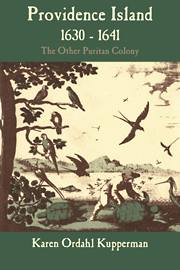Book contents
- Frontmatter
- Contents
- List of Maps
- Preface
- Author's Note
- 1 The Providence Island Company and Its Colony: The Program
- 2 Founding a Colony on Providence Island
- 3 Contested Authority: The Governorship of Captain Philip Bell
- 4 Frustrated Hopes for Economic Development
- 5 Land and Society: The Middling Planters
- 6 Servants into Slaves
- 7 Military Requirements and the People's Response
- 8 The Turbulent Religious Life of Providence Island
- 9 Governing Puritan Privateers: The Governorships of Robert Hunt and Nathaniel Butler
- 10 The Business History of the Providence Island Company
- 11 The End and Persistence of Providence Island
- Appendixes
- Bibliographical Essay
- Index
Preface
Published online by Cambridge University Press: 24 November 2009
- Frontmatter
- Contents
- List of Maps
- Preface
- Author's Note
- 1 The Providence Island Company and Its Colony: The Program
- 2 Founding a Colony on Providence Island
- 3 Contested Authority: The Governorship of Captain Philip Bell
- 4 Frustrated Hopes for Economic Development
- 5 Land and Society: The Middling Planters
- 6 Servants into Slaves
- 7 Military Requirements and the People's Response
- 8 The Turbulent Religious Life of Providence Island
- 9 Governing Puritan Privateers: The Governorships of Robert Hunt and Nathaniel Butler
- 10 The Business History of the Providence Island Company
- 11 The End and Persistence of Providence Island
- Appendixes
- Bibliographical Essay
- Index
Summary
When I first discovered the puritan colony on Providence Island, it seemed to offer the possibility of answering one key conundrum of early colonial history: Which is more important in shaping new American societies, culture or environment? The standard examination question goes something like this: What would their communities and economy have looked like if the puritans had gone to Virginia rather than to the unproductive land of New England? Providence Island, just off the coast of Nicaragua, was settled at the same time as Massachusetts Bay by the same kind of substantial puritans. Instead of creating classic New England towns based on subsistence agriculture, these puritans seemed to emulate their West Indian neighbors by pursuing plantation agriculture with slaves as their source of labor. Moreover, they indulged heavily in privateering. It seemed to be a clear and rather simple case of nature overwhelming nurture.
What I found was a far more complex and more interesting story. Because Providence Island was backed by the most substantial lay puritans in England, it was a colony that received consistent support and was the focus of great interest. Many in England believed that New England would prove to have been no more than a holding station from which the settlers would all eventually move to found a great English colony in Central America. Providence Island was to be the first beachhead of this effort.
- Type
- Chapter
- Information
- Providence Island, 1630–1641The Other Puritan Colony, pp. xi - xvPublisher: Cambridge University PressPrint publication year: 1993

